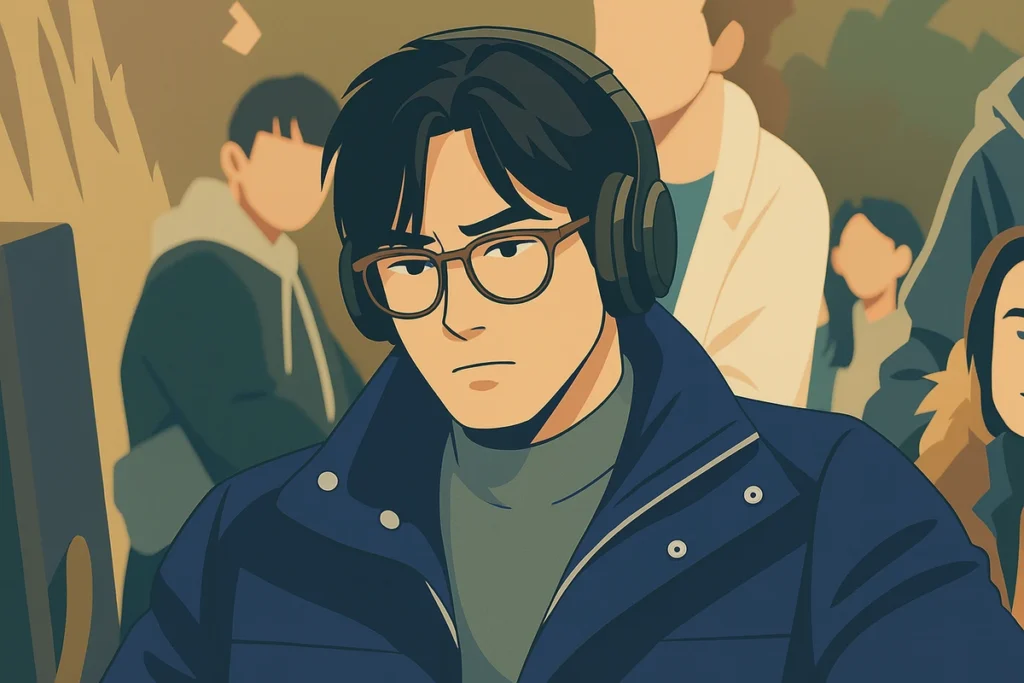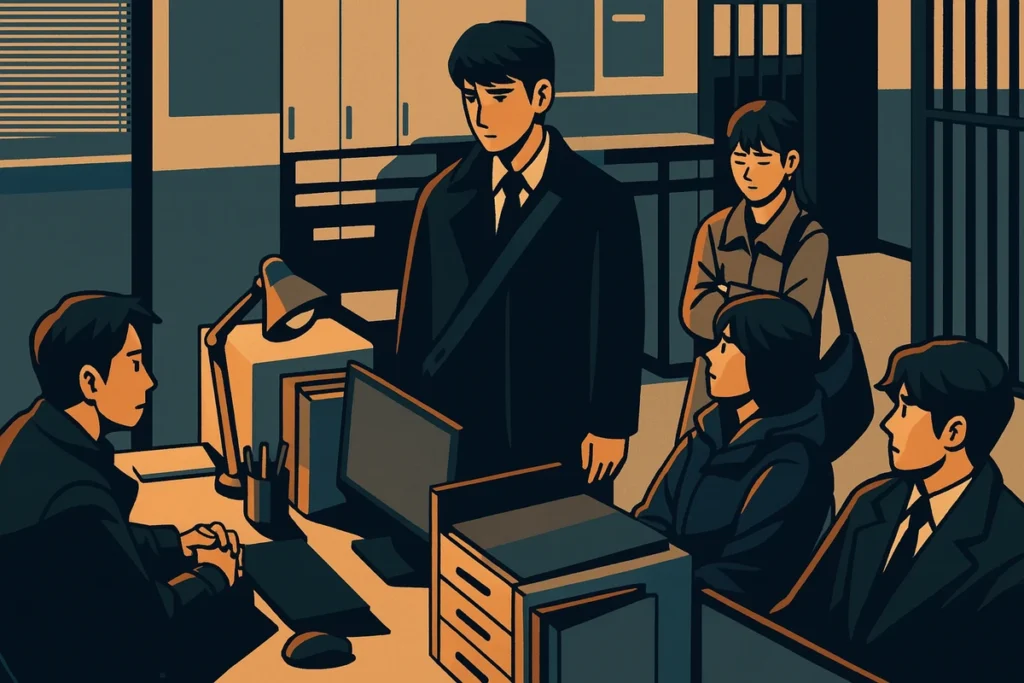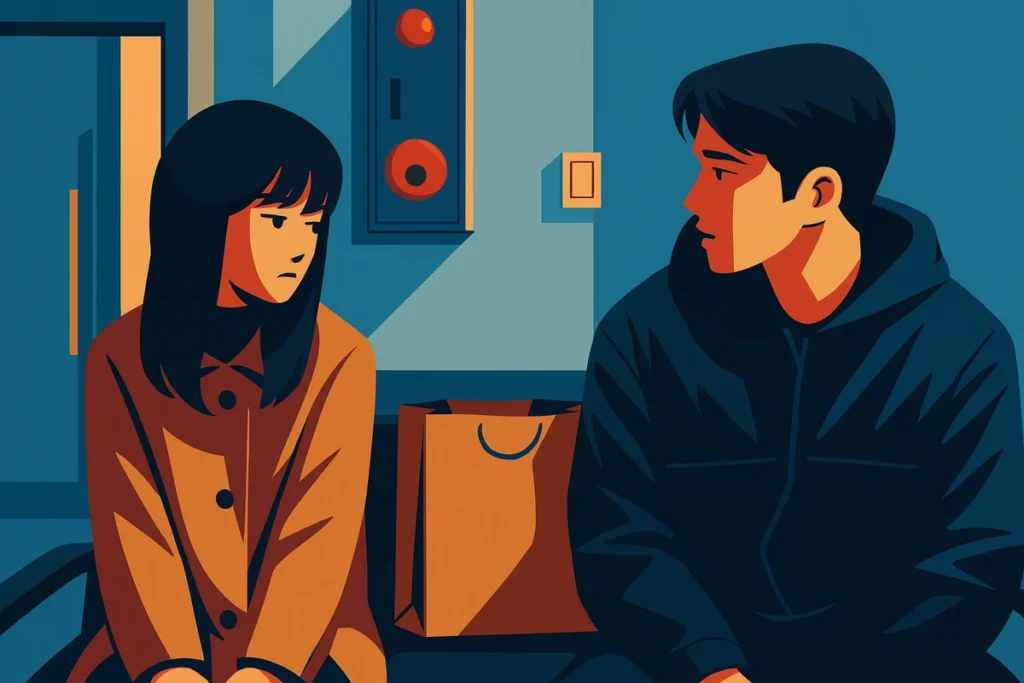[Image Source] AI illustration by DALL·E
TL;DR – Korean pain is often whispered, not shouted.
In this deeply emotional teaser for Our Movie, grief, affection, and legacy are spoken through half-sentences and lingering silence.
This post breaks down how Korean drama uses omission, indirect speech, and passive verbs to express emotional weight—perfect material for language learners craving realism.
Learn natural expressions like 꽃히다, 그게 전부야, 많이 아끼나 보네 and discover how brevity becomes a language of love.

1. Scene Snapshot
Time stretches in silence.
A character whispers not a question but a quiet plea:
“How long must I stay alive like this?”
There are no explanations, only hesitations.
In this Our Movie teaser, death and memory dance gently between an actress facing the end and a director hiding everything behind one-liners.
They don’t speak of love—they speak of what they lack.
He doesn’t say “I care.”
He says, “She has something we don’t.”
She doesn’t chase success.
She says she wants her dream to become someone else’s memory.
Even filmmaking turns into metaphor: a “take” becomes a “last take.”
For Korean learners, this is your window into indirect emotion, fragmented speech, and word order with meaning.
Lines are short—but the silence after is long.
📺 Watch the original scene here
[Source] YouTube, SBS
2. Micro-Dialogue
2-1. 언제까지 이렇게 살아야 하냐고요
How long do I have to keep going like this
Variants:
• 이게 언제 끝나죠 → When will this be over
• 더는 못 버틸 것 같아요 → I don’t think I can last much longer
2-2. 왜 자꾸 그 사람만 생각해요
Why can’t you stop thinking about her
Variants:
• 그 사람한테 왜 그리 끌리죠 → What’s pulling you toward her
• 왜 그렇게 그 사람만 눈에 들어오나요 → Why is she the only one you see
2-3. 그 사람한텐 뭔가 있어요. 우리에겐 없는 무언가
There’s something in her. Something we don’t have
Variants:
• 우리가 못 가진 걸, 그 사람은 지녔죠 → She has what we’re missing
• 그녀는 다른 결을 지녔어요 → She’s cut from a different cloth
2-4. 보니까 많이 마음 쓰이는 사람 같네요
Looks like she’s on your mind a lot
Variants:
• 꽤 소중하게 여기는 눈치예요 → Seems like you hold her dear
• 감정이 꽤 깊어 보이네요 → The feelings seem strong
2-5. 난 그걸로 충분해요. 더 바랄 것도 없어요
That’s all I need. I’m not asking for more
Variants:
• 그게 전부예요. 그 이상은 바라지 않아요 → That’s it. Nothing beyond that
• 그걸로 모든 게 설명돼요 → That says it all
3. Culture & Subtext
3-1. Questions as a shield:
Koreans often ask questions not to get answers, but to guard emotions.
Here, “Until when?” isn’t curiosity—it’s grief wrapped in grammar.
3-2. “우리” as identity:
Even in painful moments, Korean speakers use “we” instead of “I.”
Saying “우리한텐 없는…” connects the speaker to something larger—community, memory, longing.
3-3. 꽃히다 vs. 좋아하다:
This passive verb is emotionally loaded.
It’s not about choice—it’s about being emotionally caught, almost involuntarily.
3-4. Ending with “그런 게”:
Fragmented speech in Korean isn’t lazy—it’s poetic.
Leaving the thought open lets the listener feel and fill in.
3-5. Short lines, deep wounds:
In English, you might say, “That’s all I need.”
In Korean? “그게 전부야.”
Five syllables that say: I’ve accepted my limits—and it hurts.
❓ FAQ (Frequently Asked Questions)
Q1. Why does Korean drama often use incomplete lines like “그게 전부야”?
→ This is a common question on Reddit threads about Korean dialogue. One highly upvoted answer says:
“Korean drama uses abrupt or incomplete lines to let silence do the emotional heavy lifting.”
In Korean, emotional tension often comes from what’s not said. A line like “That’s all” can carry an entire history of grief or love.
Q2. What does “꽃히다” mean, and how is it different from “좋아하다”?
→ This passive verb often confuses learners. One Redditor explained it as:
“꽃히다 is a passive emotional fixation. It’s like being emotionally stuck on someone, without intending to be.”
While “좋아하다” means to like or love someone directly, “꽃히다” implies helpless attraction or fascination—more emotional depth, less control.
Q3. Why do Koreans say “우리” (we/our) instead of “I” or “my” so often?
→ A frequently discussed point among learners. A popular Reddit comment puts it this way:
“Koreans use ‘우리’ even for deeply personal things to reinforce communal identity and emotional closeness.”
That’s why you hear “우리 엄마” (our mom) or “우리한텐 없는…” (something we don’t have), even if it’s deeply personal.
Q4. Can I use phrases like “많이 아끼나 보네” with friends?
→ Yes, but be careful with tone. A Redditor said:
“It’s soft and indirect—it sounds like an observation, not a confrontation.”
This line is a gentle way to comment on someone’s feelings. In Korean culture, emotional honesty often hides inside neutral tones.
4. Grammatical Analysis of the Dialogue
4-1. “앞으로 얼마나 더 버텨야 하죠? 말씀 좀 해주시겠어요?”
🔍 Analysis
. “앞으로”: “from now on,” “going forward”
. “얼마나 더”: “how much more”
. “버텨야 하죠?”: verb 버티다 (to endure) + -아야 하다 (must) + -죠 (seeking agreement or confirmation)
. “말씀 좀 해주시겠어요?”: 말씀하다 (honorific “to say”) + -어 주시다 (do for me, polite) + -겠어요? (polite question)
📌 Example Usage
“언제까지 참고 있어야 하죠? 말씀 좀 해주세요.”
→ “How much longer do I have to endure this? Please let me know.”
☀️ Meaning
A polite but emotionally weighted plea. This line uses formal language to mask desperation, a typical Korean strategy for preserving dignity while asking for clarity in challenging moments.
4-2. “왜 그렇게 그 사람한테 빠진 건데?”
🔍 Analysis
. “왜”: “why”
. “그렇게”: “so much,” “that way”
. “그 사람한테”: “to that person”
. “빠진 건데?”: 빠지다 (to fall for, be absorbed in) + -ㄴ 건데 (past explanatory, probing question)
📌 Example Usage
“걔한테 왜 그렇게 빠졌는지 궁금해.”
→ “I’m curious why you’re so into that person.”
☀️ Meaning
The tone is light, but curious—like teasing a friend about their crush. It reflects Korean communication style: emotional questions wrapped in casual syntax.
4-3. “있잖아, 우리랑은 좀 다른 무언가가 있어.”
🔍 Analysis
. “있잖아”: softener for stating something important
. “우리랑은”: “with us” + contrast marker -은
. “좀 다른”: “a bit different”
. “무언가가 있어”: “there’s something”
📌 Example Usage
“뭔가 특별한 게 있는 것 같아, 우리랑은 다른 느낌?”
→ “Feels like there’s something special—different from us.”
☀️ Meaning
This line reflects subtle envy or admiration, expressed with restraint. It suggests emotional distance without outright negativity.
4-4. “꿈 말인가요? 소중한 사람들에게 나누고 싶어요.”
🔍 Analysis
. “꿈 말인가요?”: “Are you talking about my dream?” — polite interrogative with topic particle
. “소중한 사람들에게”: “to people I cherish”
. “나누고 싶어요”: 나누다 (to share) + -고 싶다 (want to) + polite ending
📌 Example Usage
“그 꿈, 혼자 간직하는 게 아니라 나누고 싶은 거예요.”
→ “It’s not a dream I want to keep to myself—I want to share it.”
☀️ Meaning
The focus isn’t on achievement but emotional connection. This expresses the Korean value of relational legacy—leaving parts of yourself in others.
4-5. “어쩌면 인생에서 가장 빛나는 순간일지도 모르겠네.”
🔍 Analysis
. “어쩌면”: “maybe,” “perhaps”
. “인생에서”: “in life”
. “가장 빛나는”: “the most shining” (figurative for “meaningful” or “precious”)
. “순간일지도 모르겠네”: “순간” (moment) + “-이다” (to be) + “-ㄹ지도 모르다” (conjectural: might) + “-겠-” (tentative/future nuance) + “-네” (reflective realization)
📌 Example Usage
“지금 이 시간이 가장 반짝이는 기억이 될 수도 있겠네.”
→ “This moment might become the brightest memory.”
☀️ Meaning
It’s an inner realization spoken aloud—a signature move in Korean dialogue. This phrasing helps emotional insights land softly but intensely.
5. Natural Korean Toolkit
5-1. 마음을 빼앗기다 (to be captivated)
. Alt: 빠지다 (fall for), 홀리다 (be mesmerized)
. Note: A state of emotional loss of control. This phrase is often used when someone is drawn to a person or feeling without consciously realizing it.
5-2. 더 없어요 (That’s it)
. Alt: 그게 전부예요, 그게 다예요
. Note: A direct and minimal expression. Depending on the tone, it can sound indifferent or severe.
5-3. ~던가 봐요 (It seems like ~)
. Alt: ~는 것 같아요, ~는 듯해요
. Note: A soft and indirect way to express assumptions. Often used to imply possibility without sounding too assertive.
5-4. 언제든 괜찮아요 (Anytime is fine)
. Alt: 아무 때나요, 언제라도 좋아요
. Note: Frequently used to show emotional availability, reliability, or sincere willingness to help.
5-5. 꺼내보다 (to pull out and reflect)
. Alt: 되새기다, 다시 떠올리다
. Note: A metaphorical expression. It describes recalling a memory as if physically taking it out and looking at it again.
6. Quick Quiz or Expression Drill
📝 Fill in the Blank (5)
6-1. 언제까지 ( ) 하는 건가요?
6-2. 왜 그렇게 그 사람한테 ( )?
6-3. 뭔가 ( ) 느낌이야, 우리와는 다른…
6-4. 요즘 자꾸 그 일만 ( )나 봐요.
6-5. 예전 사진을 ( ) 보게 돼요.
✅ Multiple Choice (3)
6-6. “그게 전부예요”라는 말이 담고 있는 감정은?
A. 대화 의욕 없음 B. 감정적 거리두기 C. 그게 가장 중요하다는 의미
6-7. “완전히 마음을 빼앗겼어”라는 표현은 어떤 감정을 나타내나?
A. 지루함 B. 빠져듦이나 몰입 C. 후회
6-8. 다음 중 가장 정중하게 정보를 요청하는 표현은?
A. 알려줘요 B. 알려주시겠어요? C. 알리다
📍 Want More Like This?
Curious about how Korean expresses emotion through grammar and subtlety?
These deep dives on verb endings and layered expressions will help you understand the real language behind the drama.
- 🔖 Understanding Korean Ambiguity: A Guide to the Beauty of Multilayered Expressions
- 🔖 Korean Verb Endings Explained: Essential Guide for Fluency
Answers
6-1. 살아야
6-2. 빠졌어
6-3. 특별한
6-4. 떠오르
6-5. 꺼내
6-6. C
6-8. B
6-9. B


